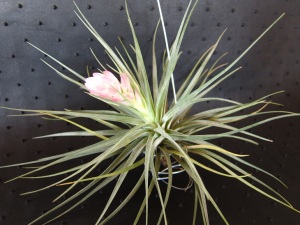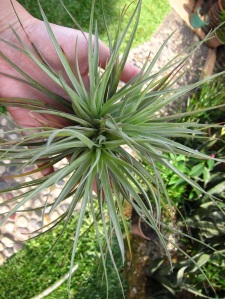Tillandsia stricta
Tillandsia stricta is a very common tillandsia, and for good reason. It is easy to grow – tolerating various growth conditions, is fast growing and even rarer still for a tillandsia, it flowers regularly. It is native to Brazil and Venezuela, growing on both the sands of beach dunes and in trees in the foothills of the Atlantic Range. This covers a large area and probably goes some way to explaining the large number of variations that can be found in strictas. Strictas are stemless and have a nice leafy rosette growing to about 6-inches or so. As I said there are a number of different variants, ranging from soft leaved examples to other much harder, stiffer types. And it does not end there, as there are also different coloured forms, from those with light green leaves to those with silvery leaves and even those verging on black (a so-called midnight variant).
The plant I bought is what I think would be termed a grey hard leaved variety. Better yet it was already spiking – and this was the main reason I bought it. After singing the praises of strictas earlier, I should now confess that I am not a huge fan of strictas in general. I just feel that they look rather, dare I say it, boring! Having said which even I am unable to resist one that was soon going to bloom, with the light pink flower bracts doing a great job of charming me. Just look at that pastel pink and tell me how anyone could resist that!
The spike was pretty well developed by the time I bought the plant, so it only took another week or so before it bloomed. By that time the flower bracts had turned a nice deep shade of pink while the flowers itself were purple. This seems to be the most common colouring although I believe I may have stumbled across pictures on the internet which had bracts and flowers with other colours. However, I must have seen this during one of my late night trawls through the internet because I doubt I can ever find them again.
Looking at the pictures of the plant in bloom, even I have to admit that they look pretty darn good! Like most tills however, stricta flowers are not long-lived, lasting for about a day at best, before it starts wilting. I can’t remember precisely but I would think I had a go at self-pollinating the plant – with no luck.
The pictures below were taken about three weeks post flowering and you can see that the spent flower has turned a light yellowish-green in colour, which I actually quite liked so I left it attached until it was fully dried up, which took a good few months. I understand you can just as easily remove the spent flower without harming the plant, but I prefer to just let it be. And of course after the bloom, what every grower loves to see, pups! Pretty quickly after the flower was spent, three pups appeared in the centre of the plant.
The pups have grown steadily over the past six months and are all now a decent enough size to be separated from the parent. But I think I will have a go at keeping it as a clump. Perhaps where a single stricta doesn’t entice me, a clump may just do the trick. As I mentioned earlier, strictas are easy to grow. I have this one in morning sun up until 12pm-1pm (regular readers will see a trend). It seems happy enough there provided it gets a good amount of watering, which translates as a good drenching daily. Otherwise the leaves very quickly start to channel. I suspect it may prefer a slightly shadier spot though so I am in the midst of trying to find some place more suitable. But hardy plant that it is, it seems to still be doing great.
Growth after five months…
Writing this made me realise I did not have any decent pictures of this plant, which made me feel like I wasn’t really doing it justice, as it really is much nicer than I am making it out to be. So I went out and took a couple more snaps. Pictures below are six months post bloom and are fresh of the errmmmm… memory card!
I hope I have not put anybody off from owning strictas as I think it should be a staple in any collection. After all I don’t even like them and yet I own three (soon to be) clumps! So what are you waiting for, go out there and get one for yourself.











Pingback: The Weekly View: Tillandsia Utriculata 2/23/13 | small house/BIG GARDEN
Pingback: Tillandsia Houston (stricta x recurvifolia) | tillandsiaaffair
I’m curious where you found your tillandsia? I bought one from a grocery store’s floral section, but when I went back for another, they weren’t carrying them any more. I’ve looked at a few of the garden centres with no luck online (though I’ve yet to go to any in person – as they’re all pretty hard to get to).
Hi Dawn,
You don’t say where you are based so I am assuming the US? There are quite a number of large Tillandsia nurseries there, Rainforest Flora International, Tropiflora, Bird Rock Tropicals, just to name a few. Not sure if they are close to where you live, but they do ship the plants. If you do a quick search for these three online, you will find plenty to keep you occupied and to start you off with. Hope that helps!